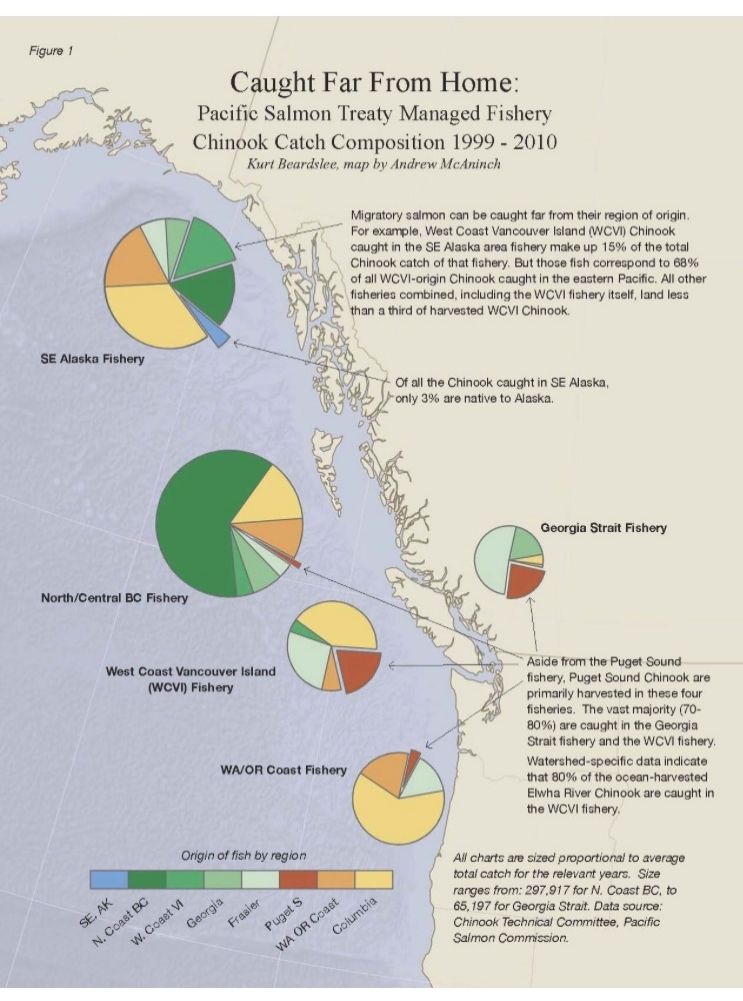Here is the latest 11-yr dataset for marine harvest of West Coast chinook stocks visually presented as pie charts sized in proportion to actual catches.

Here's the supporting text for that graph....
Caught Far From Home: Pacific Salmon Treaty Managed Fishery Chinook Catch Composition 1999 - 2010January 18, 2012
The harvest of Pacific salmon throughout the Northwest has dramatically changed over time. We have changed where, when, and how we harvest, as well as how many we catch and even why we catch them. All of these changes combined have changed the salmon itself as harvest has altered the physical size of the fish and changed the age at which they mature. Harvest has reduced their diversity and abundance and may have even affected their ability to survive over time. It is urgent that we completely reevaluate how harvest is affecting salmon recovery and how harvest must be changed.
Historically, indigenous people of the northeastern Pacific fished for salmon when the fish returned to their natal rivers. Since they fished in or near the river, the impact of the fishery was confined to the river. If a river was over-harvested the local community would suffer the consequences when the next generation of salmon returned.
European settlers arrived and brought new technologies that helped fishermen expand how and where they could fish. Sail power, then gas and diesel engines and factory canneries forever changed the ability to exploit this rich new resource. Fishers were no longer confined to fishing the rivers near their communities. In the rich, new, ocean fishing grounds, fishers caught salmon that originated from many distant rivers. This shift to an ocean fishery represents the start of the mixed-stock fishery and the dilemma it poses for us and the international managers1 that are now in charge of the fishery.
At the beginning of this new fishery almost all salmon populations were healthy, which reduced the effect of fishing on any individual stock. Today, however, stocks from up and down the coast vary dramatically as to their health. While some are healthy and suitable for harvest, other stocks may be struggling to survive, recognized as a stock of special concern, or even protected under the Endangered Species Act.
Currently, the majority of harvested salmon are caught in this mixed-stock fishery, far from their rivers of origin. The pie charts in Figure 1 illustrate where Chinook are caught in relation to where they originate. It doesn’t take long before the dilemma becomes obvious. In this environment where healthy and weak stocks are co-mingled, the fisheries should be designed and implemented to protect the weakest stocks while harvesting the most abundant. But as hard as managers may try, they can’t do it. Even with highly sophisticated modeling and forecast predictions, these tools are just too dull to meet the needs of today’s recovery efforts, if harvest rates are to be maintained.
For example, imagine the Elwha River. Soon the dams will be gone, opening up roughly seventy miles of excellent habitat within the Olympic National Park, habitat just waiting to be re-colonized. But of the Elwha Chinook that are caught in the ocean fishery, 80% of them are harvested in the West Coast Vancouver Island fishery, where fishers may be targeting the more abundant Fraser River and Columbia River Chinook. This ocean fishery management strategy, as it exists today, cannot protect returning Elwha Chinook in this co-mingled fishery without significantly reducing the harvest of the healthiest stocks. The end result is that Canada’s fishery is harming Washington’s recovery.
Another example can be illustrated by the Chinook of the west coast of Vancouver Island. There, pristine old-growth rivers where wild Chinook can thrive still exist, yet some of these rivers have as little as 1% of the Chinook they did fifty years ago. These rivers cannot afford any harvest and may never recover without managers giving priority to their recovery. That can only be done on an individual basis, but unfortunately, hundreds of miles to the north, Alaska is busy harvesting Chinook to the degree that of all of the West Coast Vancouver Island Chinook landed in the ocean fishery, 68% are caught in Alaska. Some are very likely remnants of the highly depressed stocks.
Today’s fishery management is far more precise than it was even twenty years ago, but it still lacks the ability to manage at a scale that is necessary to recover individual salmon and steelhead stocks. Fisheries management needs to change, and ending the ocean Chinook fishery should be considered. This fishery impacts Chinook the most because of their complex life history. Living the longest, Chinook are exposed to the effects of this fishery for a long period of time. Closing the ocean Chinook fishery, while allowing fishing to take place at the mouths of respective rivers, would allow for more precise management with the greatest amount of benefit to the resource and the least amount of disruption to the overall fishery. Moving harvest to the local level, coupled with the implementation of selective fishing techniques which allow the safe release of wild fish, will maximize the harvest of hatchery fish while allowing wild fish the opportunity to return to their rivers of origin.















 Previous Topic
Previous Topic Index
Index



